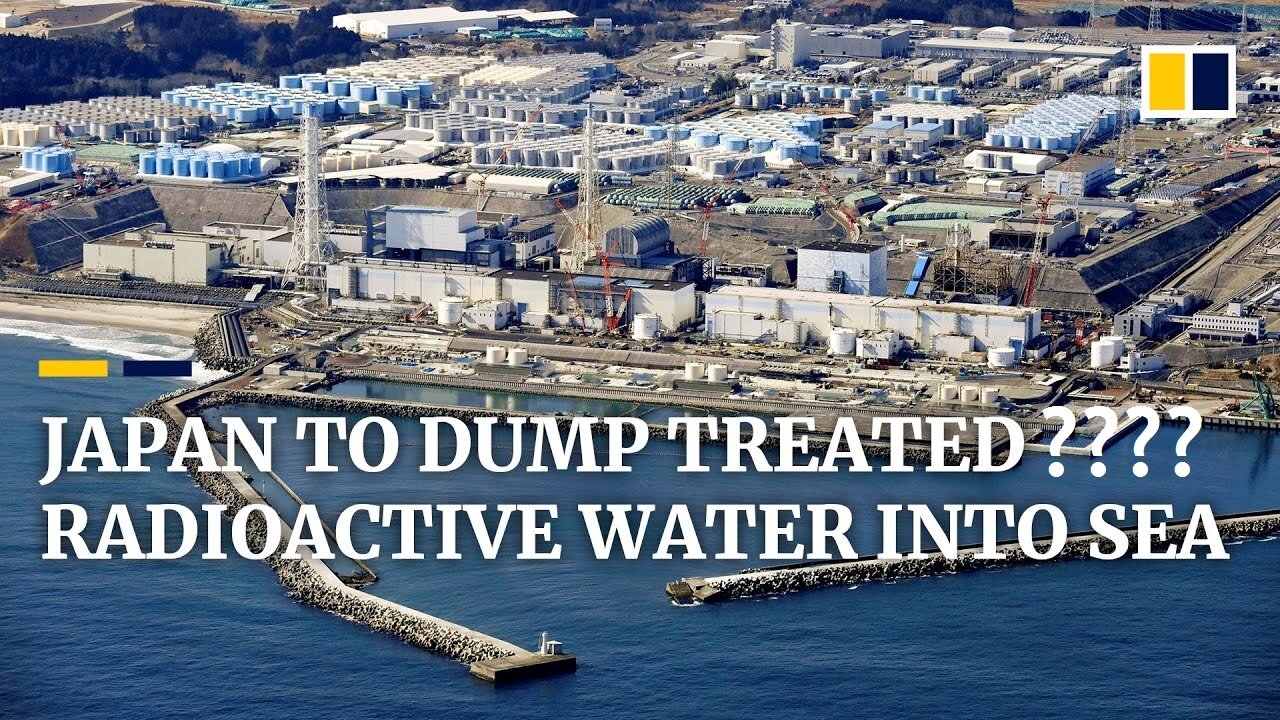Premium Only Content

Can Pacific survive 1.3m tons of Fukushima radioactive water? IAEA Ignore Health Effects Chris Busby
Dr Chris Busby
- Japan's Tepco Release 1.3 Million Tons of Radioactive Water Containing Tritium Into The Pacific Ocean
- Inadequacy Of Global IAEA Risk Model Which Ignores Health Effects
- Future of Nuclear Power in the Age of Climate Change
www.thisweek.org.uk - 01Sep23
Is the Release of Radioactive Contaminated Water From the Fukushima Nuclear Site to the Sea Acceptable? Is It Safe?
by Chris Busby
The Japanese government, having apparently run out of storage space for the million tons of radioactively contaminated water have decided to pour it into the sea. This upsets a lot of people, including the governments of China and Korea, who understandably (on a moral level, perhaps) regard this decision as unacceptable. The Japanese (also the entire nuclear industry, plus the International Atomic Energy Agency, and a long list of self-identified experts) collectively say: no problems, the quantities are very small and pose no risk to health, neither to people nor marine life. The water has apparently been treated to remove the radioisotopes that the regulators believe pose the greatest risk, Strontium-90, Caesium-137, and Carbon-14. But to take out the Tritium is too expensive, and so the radioactive water is largely contaminated with large amounts of Tritium Oxide, in the form of Tritiated water HTO.
Tritium is the largest contaminant in terms of radioactivity, disintegrations per second, clicks on a counter, from the operation of all nuclear energy processes. The neutrons, which are central to nuclear energy, produce Tritium by various processes in reactors, and even outside reactors, where the nuclide, a radioactive form of Hydrogen, is formed by adding neutrons to cooling water and various other processes. Tritium is interesting stuff. Its radioactivity is extremely weak: it emits a very short-range beta electron and itself then changes into Helium-3. What? Yes, it is a form of hydrogen, but shoots off an electron and turns into Helium-3. But we are mostly made of hydrogen, you say. Just So.
In terms of radioactivity, because the decay electron is so weak, the method that the risk agencies use to quantify radiation effects has classed Tritium as almost a non-event, in terms of health effects. This is most convenient for the nuclear industry, as it means that the exposure limits for Tritium (in terms of Becquerels per litre) are truly enormous, when compared with other radioactive waste. Tritium has a 12-year half life, so it hangs about. And since all life depends on water, and indeed all life mostly is water, hydrogen and oxygen, introducing radioactive water into the environment might seem to be a bad idea.
But No! The low beta energy of Tritium allows the regulators to argue that the releases of huge amounts to the sea and rivers is safe. But the regulators are wrong. The system of analysis using the concept of “Absorbed Dose” is unscientific, dishonest and at the origin of a huge historic public health scandal that has caused hundreds of millions of deaths from cancer due to badly regulated releases of certain specific contaminants, and this includes Tritium, Carbon-14, Uranium (as particles) and certain other substances produced by nuclear processes. Many years ago, the regulator BEIR committee in USA under Prof Karl Z Morgan tried to change the limits for Tritium, but he was overruled because it would make the operation of nuclear power very difficult. He wrote about this in his book The Angry Genie. He was convinced that Tritium was a serious hazard.
So, lets look a bit closer at the quantities. The water in the tanks contains about 1500Bq/litre. A Becquerel is one decay per second. A litre of this water would produce 1500 clicks on a suitable measuring instrument (not a Geiger Counter, you won’t measure this stuff with a Geiger counter). Does that sound a lot? Would you drink this water? Even if the IAEA say it’s OK? Would They?
The total amount to be released is 1.3 million tons. Or we are told, 22 TeraBecquerel. That is 22,000,000,000,000Bq. Sounds a lot. It is a lot. But of course, the Pacific Ocean is large, and hopefully it will just go away through dilution. And it seems 22TBq, is small compared with the quantities released by the nuclear reprocessing plants in Europe. Sellafield in the UK pumped out 432 TBq a year (20 times more) to the Irish Sea and La Hague in France 10,000TBq/y (450 times). So that’s OK then. The experts say (and you can Google them on the Science Media Centre), or you can believe the IAEA, or the Japanese, that this stuff has never shown any health effects in places where it is poured into the sea.
-
 LIVE
LIVE
Right Side Broadcasting Network
18 hours agoLIVE: House Judiciary Hearing on Antitrust Law and the NCAA - 3/11/25
2,040 watching -
 LIVE
LIVE
The Tom Renz Show
34 minutes agoThe Globalist Engineered Economic Collapse Beginning With Attacks on Elon Musk, X & Tesla
153 watching -
 LIVE
LIVE
The Big Mig™
12 hours ago“DEI with a Side of Debt: Biden’s Trillion-Dollar Giveaway”
2,339 watching -
 1:17:34
1:17:34
Dear America
12 hours agoMassive Cyberattack Against Elon's X Sparks Widespread CONCERN! + More Attacks On Tesla Vehicles?!
43.1K11 -
 LIVE
LIVE
Wendy Bell Radio
6 hours agoOver The Target
11,917 watching -
 LIVE
LIVE
Bitcoin Policy Institute
2 hours agoBitcoin for America
394 watching -
 1:05:29
1:05:29
2 MIKES LIVE
2 hours agoTHE MIKE SCHWARTZ SHOW with DR. MICHAEL J SCHWARTZ 03-11-2025
11.8K1 -
 34:43
34:43
Degenerate Jay
1 day ago $2.60 earnedAssassin's Creed Was Always Anti-Religion?
37.1K6 -
 6:41
6:41
Silver Dragons
20 hours agoCanadian Silver Maple Leaf Coins - Dealer Reveals Everything You NEED to Know
29.5K3 -
 8:42
8:42
Dangerous Freedom
18 hours ago $2.07 earnedThe M&P Competitor SHREDS—But Did Smith & Wesson Screw It Up?
28.8K2